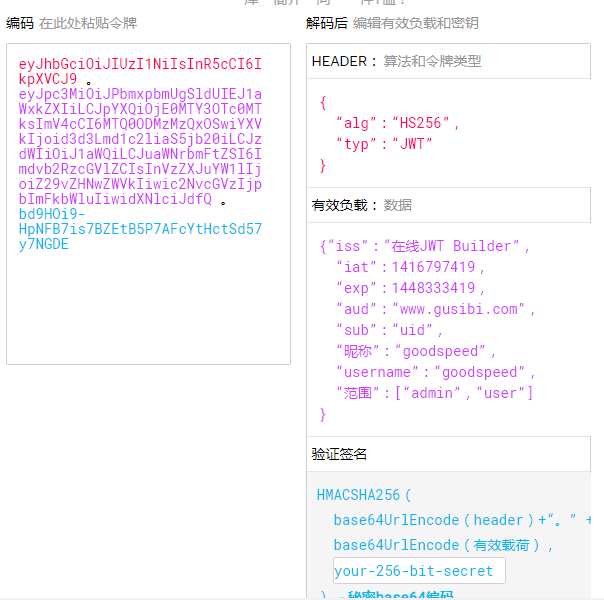python实现JWT
一、常见的几种实现认证的方法
1.1basic auth
1.2cookie
1.3token
json web token--一种基于token的json格式web认证方法。基本原理是,第一次认证通过用户名和面膜,服务端签发一个json格式的token,后续客户端的请求都带着这个token,服务端仅需要解析这个token,来判断客户端的身份和合法性。jwt协议只是规范了这个协议的格式,分为三个部分
1.3.1header头部
{
'type':'JWT', #声名类型,这里是JWT
'alg':'HS256' #声名加密的算法,通常为 HMAC SHA256
}
再将其解析base64编码
1.3.2payload载荷
payload是放置实际有效信息的地方。jwt定义了几种内容,包括: 标准中注册的声明,如签发者,接收者,有效时间(exp),时间戳(iat,issued at)等;为官方建议但非必须 公共声明 私有声明
#一个常见的payload
{
'user_id':12345,
'user_role':admin,
'iat':14234234
}
// 包括需要传递的用户信息;
{ "iss": "Online JWT Builder", #该JWT的签发者,是否使用是可选的;
"iat": 1416797419, #在什么时候签发的(UNIX时间),是否使用是可选的;
"exp": 1448333419, #什么时候过期,这里是一个Unix时间戳,是否使用是可选的;
"aud": "www.gusibi.com", #接收该JWT的一方,是否使用是可选的;
"sub": "uid", #该JWT所面向的用户,是否使用是可选的;
"nickname": "goodspeed",
"username": "goodspeed",
"scopes": [ "admin", "user" ]
}
1.3.3signature
原理
// 根据alg算法与私有秘钥进行加密得到的签名字串; // 这一段是最重要的敏感信息,只能在服务端解密; HMACSHA256( base64UrlEncode(header) + "." + base64UrlEncode(payload), SECREATE_KEY )
第三部分是个签证信息,有三部分组成:
header(base64后的)
payload(base64后的)
secret
存储了序列化的secreate key和salt key。这个部分需要base64加密后的header和base64加密后的payload使用.连接组成的字符串,
然后通过header中声明的加密方式进行加盐secret组合加密,然后就构成了jwt的第三部分。
示例图:

二、认证需求
目标场景是一个前后端分离的后端系统,用于运维工作,虽在内网使用,也有一定的保密性要求 API为restful+json的无状态接口,要求认证也是相同模式 可横向扩展 较低数据库压力 证书可注销 证书可自动延期 这样就选择JWT
三、JWT实现
如何生成token

import jwt import time # 使用 sanic 作为restful api 框架 def create_token(request): grant_type = request.json.get('grant_type') username = request.json['username'] password = request.json['password'] if grant_type == 'password': account = verify_password(username, password) elif grant_type == 'wxapp': account = verify_wxapp(username, password) if not account: return {} payload = { "iss": "gusibi.com", "iat": int(time.time()), "exp": int(time.time()) + 86400 * 7, "aud": "www.gusibi.com", "sub": account['_id'], "username": account['username'], "scopes": ['open'] } token = jwt.encode(payload, 'secret', algorithm='HS256') return True, {'access_token': token, 'account_id': account['_id']} def verify_bearer_token(token): # 如果在生成token的时候使用了aud参数,那么校验的时候也需要添加此参数 payload = jwt.decode(token, 'secret', audience='www.gusibi.com', algorithms=['HS256']) if payload: return True, token return False, token
如何解析token
四、优化
总结
我们做了一个JWT的认证模块: (access token在以下代码中为'token',refresh token在代码中为'rftoken') 首次认证 client -----用户名密码-----------> server client <------token、rftoken----- server access token存续期内的请求 client ------请求(携带token)----> server client <-----结果----------------- server access token超时 client ------请求(携带token)----> server client <-----msg:token expired--- server 重新申请access token client -请求新token(携带rftoken)-> server client <-----新token-------------- server rftoken token超时 client -请求新token(携带rftoken)-> server client <----msg:rftoken expired--- server 如果设计一个针对此认证的前端,需要: 存储access token、refresh token 访问时携带access token,自动检查access token超时,超时则使用refresh token更新access token;状态延期用户无感知 用户登出直接抛弃access token与refresh token
